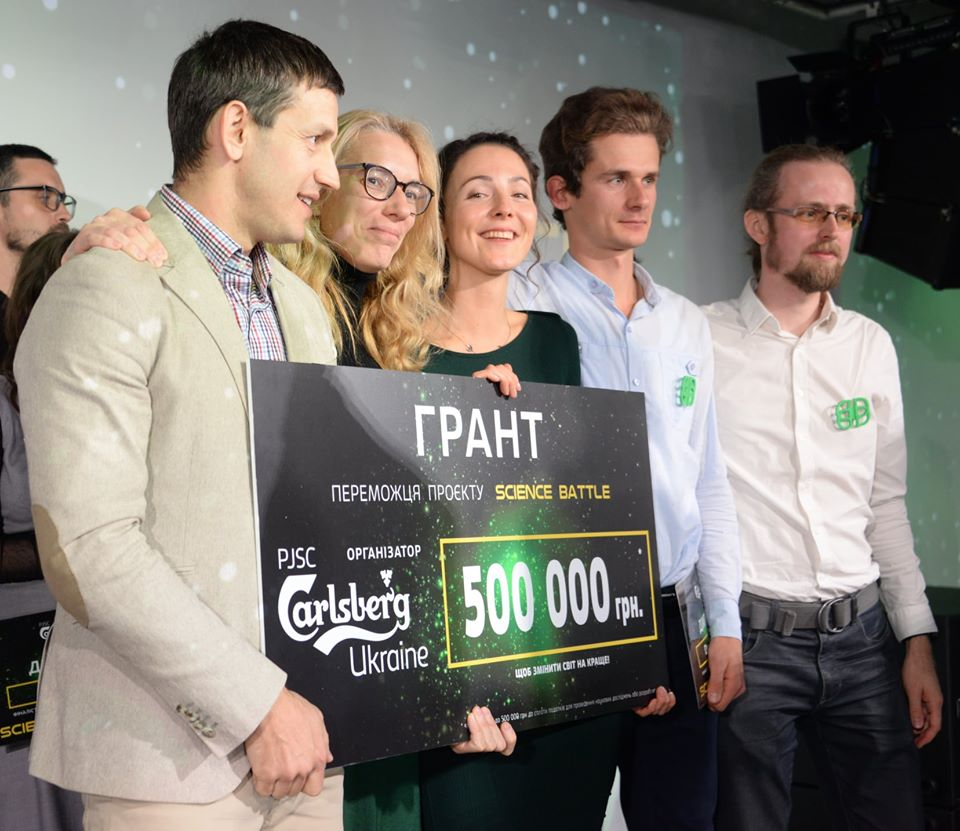What is Druid Drone? Why is it needed? How does it work
By taking care of trees, we improve our surroundings, trapping dust and harmful air emissions from large industries, especially in huge cities. However, in Europe these green barriers meet the challenge of mistletoe – the widely distributed hemiparasitic plant Viscum album L.

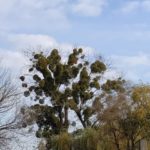
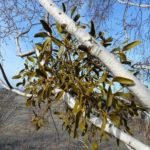
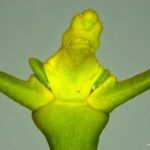
Photos: V. Leonenko (V.Vetrogradskiy)
This “biological pirate” has already affected some 30% and over 50 species of trees and shrubs in Ukraine. It steals water and nutrients from the host trees, causing the reduction of their lifespan, and "opens the gate" to harmful microorganisms and fungi.
The spread of mistletoe is usually controlled mechanically by removing mistletoe along with a considerable chunk of the host branch. Scientifically-based efficient prophylactic pruning of branches parasitized by mistletoe is required for the eradication of its inner root-like parts called haustoria, since from their remnants the green part will resprout within the next few years.

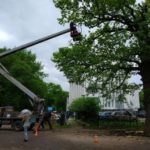
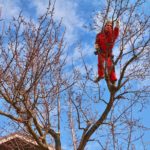
Photos: V. Leonenko (V.Vetrogradskiy)
However, this approach is too radical, because the infected tree may lose a majority of the leaves critical for its survival. In the most severe cases after such kind of “improvements” the healthy tree is reduced to the tree trunk containing no leaves! In addition, this method of mistletoe management is extremely time-consuming, since each infected tree requires a team of at least two people − arborist and a manipulator/truck driver – to work for more than 5 hours. Moreover, it is usually impossible to reach thin peripheral branches in the upper part of the crone.
Alternatives? Plant growth regulators. However, not all of them are safe, environmentally friendly and efficient if sprayed in the traditional way. As such, no acting strategy and management recommendations to mistletoe control exist in Ukraine at the moment. It is noteworthy that just the non-selective cutting of the mistletoe twigs is erroneous, because the mistletoe is one of the key biodiversity hotspots in natural and urban ecosystems. For instance, evergreen mistletoe branches provide food and shelter for animals: in Ukraine 21 species of birds are nesting in mistletoe, including those protected by the Red Book. Undoubtedly, we must control mistletoe distribution, but perform it selectively and in a nature-friendly manner.
Our team offers a solution − Druid Drone with a multifunctional manipulator Druid Assistant attached to commercially available light drones. Our Druid Assistant manipulator has five changeable instrumental modules − Green Doctor, Seсator, Sampler, Observer, and Collector.
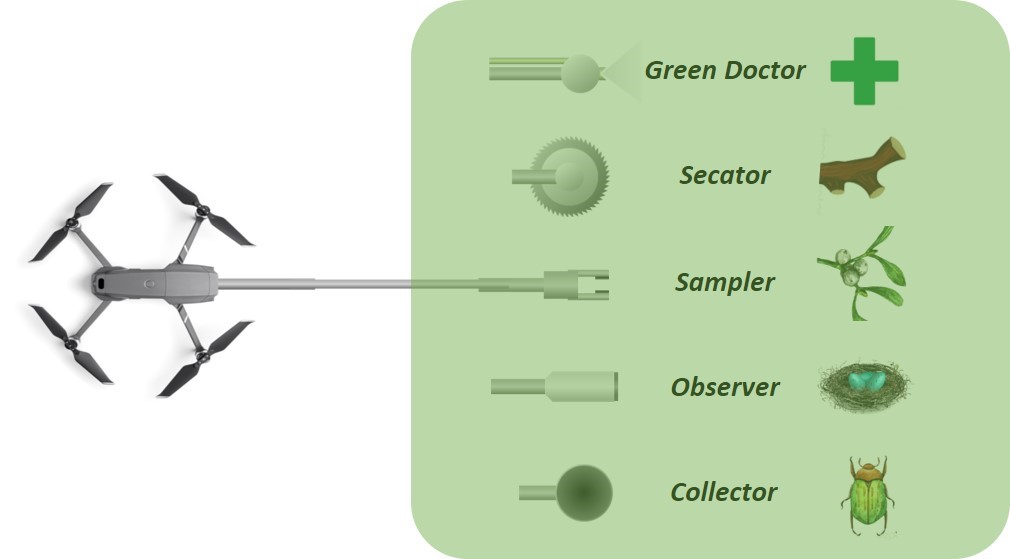
Green Doctor and Secator help arborists to target mistletoe by cutting or delivering growth regulators to the remote and thin side-branches.
Sampler allows botanists, mycologists, phytopathologists and other researchers to get intact and fresh samples from the mistletoe and/or host trees.
In turn, the Observer instrumental unit empowers ecologists and ornithologists to reveal the birds’ nests in mistletoe twigs and monitor the canopy biodiversity.
Finally, the Collector traps invertebrates at different lifecycle stages for entomologists.
How did the idea for Druid Drone come about?
The initial idea of the construction of a robotic assistant able to collect samples and observe mistletoe inhabitants emerged several times, originating naturally from the “simple research needs” of plant cell biologist Yuliya Krasylenko, who risked falling down from frozen oak branches in multiple attempts to collect herbarium samples from yellow mistletoe (Loranthus) in wintertime, or during the sampling of Crimean dwarf mistletoe (Arceurthobium) twigs from the extremely spiky branches and stems of the Eastern prickly juniper.
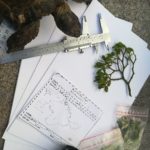

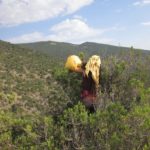
Photos: Y. Krasylenko, P. Zabizhko
What next for your project?
The final goal of the project is to develop a management recommendation for local services aimed to control mistletoe in Ukraine basing on our botanical, phytopathological, ornithological, and entomological studies using Druid Drone. We have already started to map mistletoe localities and review the host trees from the Ukrainian herbaria, own observations and observations of volunteers from the Ukrainian Botanical Group and UkrBIN (National Biodiversity Information Network) as citizen science projects, which will help us to define the spots of heavy mistletoe infestation. Moreover, we are going to cooperate with foreign colleagues to test the drone in tropical ecosystems: Luiza Teixeira-Costa (Department of Organismic and Evolutionary Biology, Harvard University Herbaria, Cambridge, USA), David Watson (Institute for Land, Charles Sturt University, Albury, Australia), Gregorio Ceccantini (Institute of Biosciences, University of Sao Paulo, Brazil) and David Shaw (Department of Forest Ecosystems; Society Forest Engineering, College of Forestry, Oregon State University, USA).
Who is on the team?
We jokingly call ourselves “modern druids” since our Druid Drone team is quite balanced due to its multifaceted expertise represented by a plant cell biologist, ornithologist, constructor, arborist and mathematician, namely:
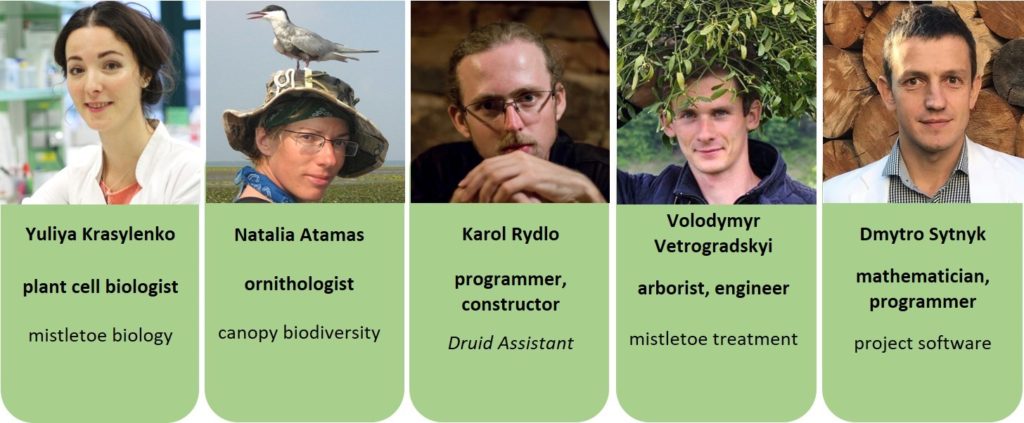
What type of research are the scientists on the team currently doing?
Yuliya A. Krasylenko, PhD, plant cell biologist from the Department of Cell Biology, Centre of the Region Haná for Biotechnological and Agricultural Research and Palacký University Olomouc; and the Department of Cell Biology and Biotechnology, Institute of Food Biotechnology and Genomics, National Academy of Sciences of Ukraine is the “Druid Drone” founder and team leader, studying anatomical details of haustoria (connecting bridge between the mistletoe and susceptible host tree), pathogenic fungi, which infect mistletoe sampled with Druid Drone Sampler/Collector instrumental units, and effects of novel growth regulators on mistletoe development. Her main research interests are cell biology (e.g., cytoskeleton) and ecology of parasitic plants, strigolactone role in plant growth and development as well as cell mechanisms of host colonization: https://www.researchgate.net/profile/Yuliya_Krasylenko
Natalia S. Atamas, PhD, ornithologist and famous Ukrainian impresario of science from the Laboratory of Population Ecology, I.I. Schmalhausen Institute of Zoology, National Academy of Sciences of Ukraine is studying birds nesting in mistletoe and organizes data collection from the Ukrainian birdwatcher’s community. She is involved in SRT for tree climbing and field testing of the Druid Drone Observer instrumental unit. Natalia is particularly interested in colonial water birds’ communities and nesting ecology, bird wooden species in transformed ecosystems, invasion processes, and fauna synurbization (e.g., trushes Turdus sp.).
https://www.researchgate.net/profile/Natalia_Atamas
Karol Rydlo, Head of Technological Department, Zall Letov Simulátory s.r.o., PhD student at the Faculty of Information Technology, Brno University of Technology (Czech Republic) focused on the development of hybrid flight control systems for autopilots. His experience in aircraft system simulation (FSTD simulators certificated as FNPT II and FTD), force feedback control system, flight dynamics simulations, navigation systems, and avionic systems are of extreme value for Druid Drone's success, since he is responsible for the construction and piloting of Druid Assistant manipulator. Karol was involved in many projects: Simulator FNPT II MCC HiBIRD Flight Simulator (2018, Polish Air Force Academy, Deblin); Simulator FNTP II MCC & FTD L410 UVP E 20 (2016−2018, University of Žilina, Airport Žilina, Slovakia); Stability and controllability augmentation system (SCAS) (2014−2015, NAU, Kyiv) and others.
https://www.researchgate.net/profile/Karol_Rydlo
Volodymyr V. Leonenko (Vetrogradskyi), is an engineer-constructor (Kyiv National University of Construction and Architecture, former name Kyiv Civil Engineering Institute), landscape designer and practicing nature-friendly arborist with more than 16 years of experience, who is implementing an ecosystem holistic approach in his everyday practice. In Druid Drone his role in field testing of Druid Drone Green Doctor/Secator instrumental units is crucial due to his in-hand experience to treat trees at high altitudes using arboristic equipment, applied phytopathology, green roofing, tree surgery, transplantology and further recovery. Volodymyr is famous for saving many trees in the historical part of Kyiv and regular monitoring of his “patients,” so we will be on a safe side with the mistletoe with his approach.
https://www.facebook.com/vladimir.vetrogradskiy
Dmytro O. Sytnyk, PhD, senior researcher of the Department of Numerical Mathematics, Institute of Mathematics, National Academy of Science of Ukraine is currently focused on the development of the Druid Drone platform with Druid Assistant manipulator and software programming for the statistical processing of mistletoe infection rate data in urban areas. His scientific interests range from numerical analysis, differential equations and linear algebra in mathematics to the theory of algorithms, parallel programming, scientific computations, code profiling and optimization in computer science as well as multi-scale phenomena in quantum heterostructures with applications to photonics and quantum computing in physics. He works on multiband Hamiltonians of the Luttinger-Kohn theory and ellipticity requirements.
https://www.imath.kiev.ua/~sytnik/
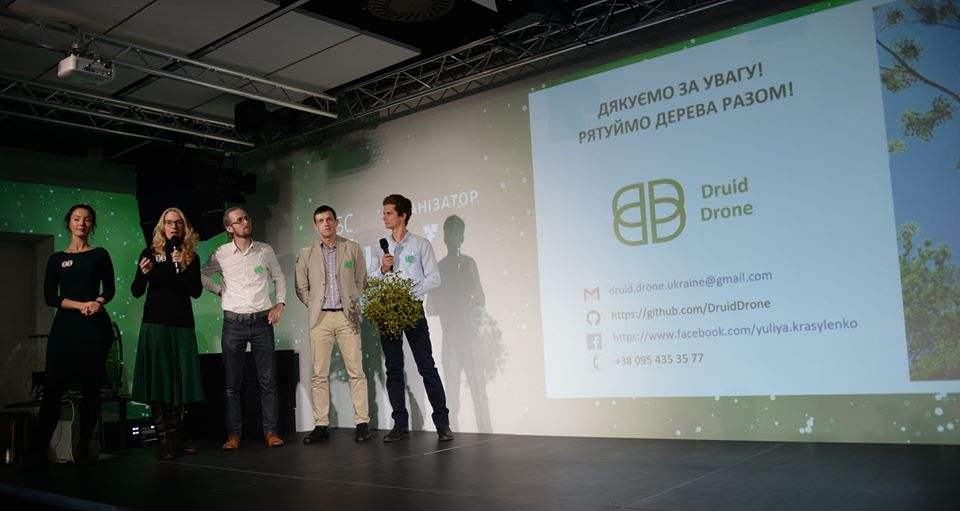
In November 2019 we won 500,000 UAH in the Carlsberg Ukraine Science Battle. We greatly appreciate the support of the Carlsberg fund and believe the grant will help us to develop a science-based strategy of mistletoe control in Ukraine using unmanned aerial vehicles as well as to reveal new aspects of mistletoe biology.
 -The Druid Drone Team & Yuliya Krasylenko
-The Druid Drone Team & Yuliya Krasylenko
druid.drone.ukraine@gmail.com

